- Quick Read
- Deep Read ( 10 Min. )

Why is Christian Science in our name?
Our name is about honesty. The Monitor is owned by The Christian Science Church, and we’ve always been transparent about that.
The Church publishes the Monitor because it sees good journalism as vital to progress in the world. Since 1908, we’ve aimed “to injure no man, but to bless all mankind,” as our founder, Mary Baker Eddy, put it.
Here, you’ll find award-winning journalism not driven by commercial influences – a news organization that takes seriously its mission to uplift the world by seeking solutions and finding reasons for credible hope.
Explore values journalism About usMonitor Daily Podcast
- Follow us:
- Apple Podcasts
- Spotify
- RSS Feed
- Download
TODAY’S INTRO
Hot dogs and volcanoes
 Mark Sappenfield
Mark Sappenfield
For the past week, the world has gotten a glimpse of a spring campfire, Iceland-style. When the Fagradalsfjall volcano erupted 17 miles south of the capital city of Reykjavík, people did not flee in terror. They came by the thousands to watch the fountains of lava. “It’s absolutely breath-taking,” said one visitor. “It smells pretty bad,” said another. A few cheeky scientists even cooked hot dogs on the lava flow.
Different volcanoes behave differently. Ash from Iceland’s Eyjafjallajökull famously disrupted European air travel for about a week in 2010. But when your island is basically nothing but volcanoes, you learn to live with them – and how to predict what they’ll do. A March 12 article in The Reykjavík Grapevine began with the words: “By the time you read this, a volcano may have erupted.” Exactly one week later, it did.
With an array of sensors detecting seismic activity and ground deformation, Iceland knew this was coming. What’s more, data suggests this could be the beginning of a volcanic cycle that happens every 800 years. “If this transpires,” writes National Geographic, “the Reykjanes Peninsula could be bathed in the glow of a thousand volcanic fires that ignite, disappear, and then reappear intermittently for an entire human lifetime.”
That’s a lot of hot dogs.
Share this article
Link copied.

Help fund Monitor journalism for $11/ month
Already a subscriber? Login

Monitor journalism changes lives because we open that too-small box that most people think they live in. We believe news can and should expand a sense of identity and possibility beyond narrow conventional expectations.
Our work isn't possible without your support.
A deeper look
Chauvin trial: Why Minneapolis activists are looking beyond the verdict
George Floyd’s death changed the conversation on police in America, launching the biggest civil rights movement in 50 years. What will Derek Chauvin’s trial mean for that movement?

The video of Officer Derek Chauvin kneeling on George Floyd’s neck as two other officers held him down and a third stood by touched off nationwide protests against police brutality and racial inequality. The uproar gave rise to the country’s broadest grassroots movement since the civil rights era.
Ten months later, with Mr. Chauvin’s murder trial underway at a downtown courthouse fortified by concrete barricades, armored military vehicles, and National Guard troops, momentum for change has slowed and splintered. An increase in violent crime in Minneapolis since Mr. Floyd’s death has fanned opposition to new public safety models, while the pandemic has compounded racial disparities in income, housing, and health care.
The trial of Mr. Chauvin – who faces charges of second- and third-degree murder and manslaughter – has deepened the sense of foreboding in the state’s largest city. But irrespective of the verdict, activists vow to press on in the name of racial justice.
“I pray the jury does the right thing, but what people want is bigger than one trial,” says Irma Burns, whose youngest son, Jamar Clark, was shot and killed by police here six years ago. “We want systemic change.”
Chauvin trial: Why Minneapolis activists are looking beyond the verdict

The eyes of Jamar Clark peer out from a poster attached to a tree near the spot where a Minneapolis police officer shot and killed him in 2015. On a recent afternoon, Irma Burns stood beside the makeshift memorial with phone in hand, taking photos of the image of her dead son.
Mr. Clark’s fatal shooting six years ago ignited an 18-day protest outside the 4th Precinct police station two blocks away. The upheaval laid bare long-running tensions between the city’s communities of color and its mostly white police force – tensions that continued to build before detonating last May when officers killed George Floyd.
“Our Black community has been hurting a long time,” Ms. Burns says. Local and federal authorities declined to bring charges against the two white officers involved in the death of the 24-year-old Mr. Clark, the youngest of her 10 children. “What happened to George was just the latest tragedy.”
The video of Officer Derek Chauvin kneeling on Mr. Floyd’s neck as two other officers held him down and a third stood by touched off nationwide protests against police brutality and racial inequality. The uproar gave rise to the country’s broadest grassroots movement since the civil rights era as supporters called for Minneapolis and other cities to defund and reform police departments and rethink violence prevention strategies.
Ten months later, with Mr. Chauvin’s murder trial underway at a downtown courthouse fortified by concrete barricades, armored military vehicles, and National Guard troops, momentum for change has slowed and splintered here. An increase in violent crime in Minneapolis since Mr. Floyd’s death has fanned opposition to new public safety models, while the pandemic has compounded racial disparities in income, housing, and health care.
The trial of Mr. Chauvin – who faces charges of second- and third-degree murder and manslaughter – has deepened the sense of foreboding in the state’s largest city. The prospect of the 12-member jury acquitting the former officer stirs concerns among residents that Minneapolis could erupt in fury again, imperiling progress on public safety reforms.
Ms. Burns and her fellow advocates, convinced that the trial’s emotional toll will fall hardest on minority residents, intend to sustain pressure on local officials to remedy the city’s policing problems, irrespective of the verdict. They view the outcome and the potential for unrest in the context of the ceaseless fight for racial justice.
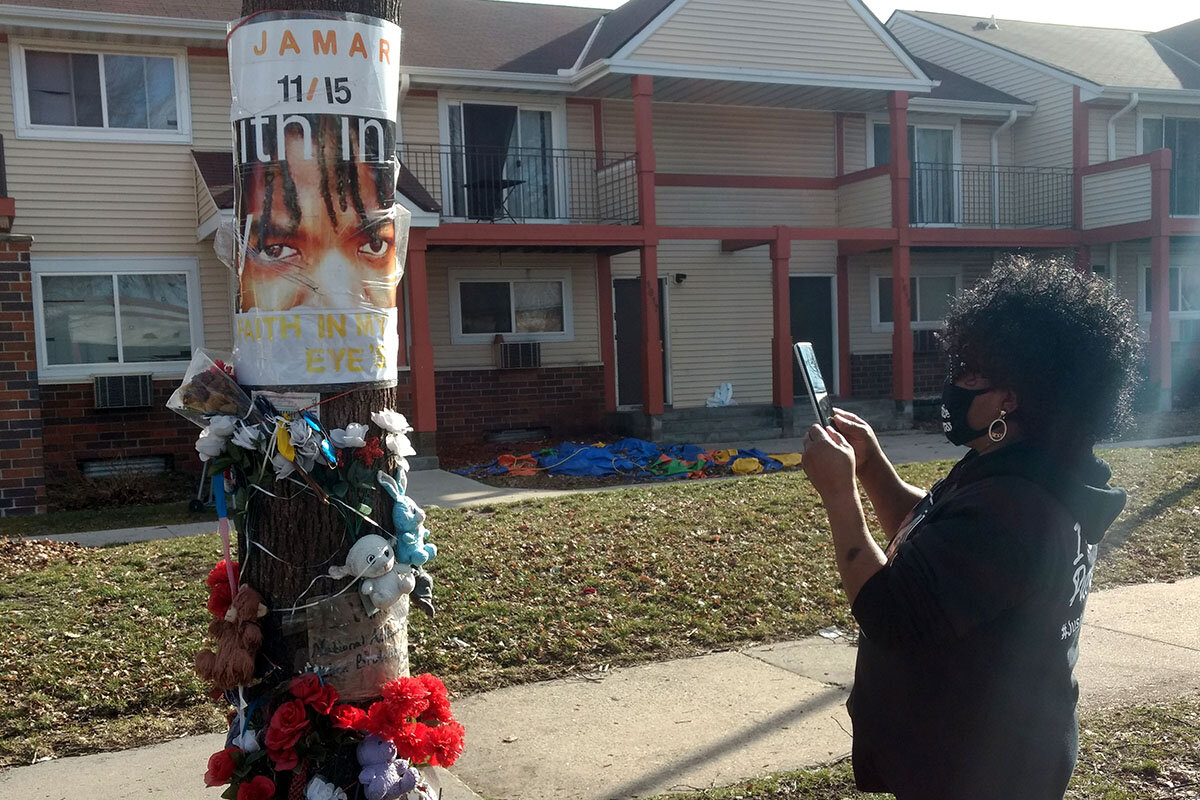
“I pray the jury does the right thing, but what people want is bigger than one trial,” Ms. Burns says. She took part in a rally outside the 4th Precinct last week to boost a ballot initiative that would establish a new civilian commission on police accountability. “We want systemic change.”
As competing proposals to shape the future of the police department vie for public attention, activists and organizers recognize that the trial’s verdict could have profound effect on their ability to recruit and retain supporters. Trahern Crews, the lead organizer of Black Lives Matter Minnesota, suggests that a conviction would prove at once cathartic and galvanizing for people of color in Minneapolis and beyond.
“I feel like the whole city is on edge, because the world is watching us,” he says. “It’s one of the most important trials in the history of the country, and we need a win. The Black community needs a win. A guilty verdict will reenergize us.”
“Live in the nuance”
Nine members of the Minneapolis City Council appeared on a stage in a city park less than two weeks after Mr. Floyd’s death last spring. The words “Defund Police” adorned the front of the platform, and the officials vowed to “end policing as we know it,” drawing cheers from the hundreds of people gathered.
The pledge earned national headlines and praise from progressive activists, who had pressed council members to take decisive action as the city reeled and raged. Days later, the 13-member council unanimously passed a resolution to initiate a yearlong process to “create a transformative new model for cultivating safety” – a signal that pursuing reforms would require patience as much as persistence.
The resolution received far less notice, and then as now, Council Member Phillipe Cunningham, who addressed the crowd in the park in June, emphasized the difference between proclaiming change and forging policy.
“I believe we need to reimagine public safety, but defunding the police is a transition – it’s not an end goal or a strategy,” he says. “Just taking money away from police isn’t enough because public safety involves much more than policing.”
His perspective tracks with popular opinion in Minneapolis. A poll conducted in August found that almost three-fourths of residents favored redirecting a portion of police funding to mental health, drug treatment, and other social services. At the same time, 60% of respondents overall – and 75% of Black respondents – opposed or expressed uncertainty about reducing the size of the force.
National polls show a similar preference for revamping rather than gutting police departments, and Minneapolis officials began to recalibrate public safety resources in December. The council passed a measure that maintained the maximum number of officers at 888 while slicing $8 million from the department’s budget to expand the Office of Violence Prevention and fund crisis response teams.
“To say that we have to either add more police and jails or we have to solve racism – that those are the only two options – doesn’t reflect the realities of creating policy,” says Mr. Cunningham, who co-wrote the initiative. “You have to live in the nuance.”
Progressive activists counter that officials have failed to fulfill the expectations they raised with their declaration in the park, and with reform caught in the gears of bureaucracy, the city has endured a spike in homicides, robberies, and other violent crimes.
“There was a worldwide outcry to dismantle the police,” says Nekima Levy Armstrong, a civil rights attorney who leads the Racial Justice Network. “Ten months later, it’s clear our elected officials did not take that seriously.”

The pace of reform
Ms. Levy Armstrong, former president of the local NAACP chapter, recalls protesting Mr. Clark’s death at the hands of police in 2015. She says city leaders largely ignored the pleas of communities of color to embrace new public safety strategies and divert more money to social programs.
The gulf separating the respective budgets of the police department and the Office of Violence Prevention – $170 million vs. $7.4 million – gives her little reason to hope that the near future will depart from the recent past.
“If the current system worked,” she says, “Derek Chauvin would not have felt comfortable putting his knee on George Floyd’s neck at all, let alone for nine minutes.”
The council approved an agreement with the state last summer that bans Minneapolis officers from applying chokeholds and strengthens rules that they must intervene when colleagues use excessive force. Yet activists complain that police remain too quick to escalate confrontations. A video emerged last week that showed an officer punching a Black teenager in the head in the confused aftermath of an apparent carjacking.
“Police keep harming people,” says JaNaé Bates, communications director with ISAIAH, a statewide network of faith organizations that promotes racial justice. “That’s the elephant in the room – we can’t get the safety results we want with the group of people we hire to do the job.”
Minneapolis officials agreed earlier this month to pay $27 million to Mr. Floyd’s family to settle a civil lawsuit over his death. For D.A. Bullock, a Minneapolis organizer and filmmaker, the true worth of the payment – one of the largest of its kind in the country’s history – will be revealed by the city’s commitment to preventing police-involved deaths.
“The $27 million is not enough value for a life,” he says. “So the value will be making sure that what happened to George Floyd never happens again.”
At George Floyd Square
The intersection where police killed Mr. Floyd soon evolved into a memorial site that provided the backdrop to a city’s sorrow. Visitors wrote chalk messages of grief, anger, and resolve on the pavement and laid flowers beneath a mural of Mr. Floyd. They came to mourn, to commune with one another, to find solace among neighbors and strangers alike.
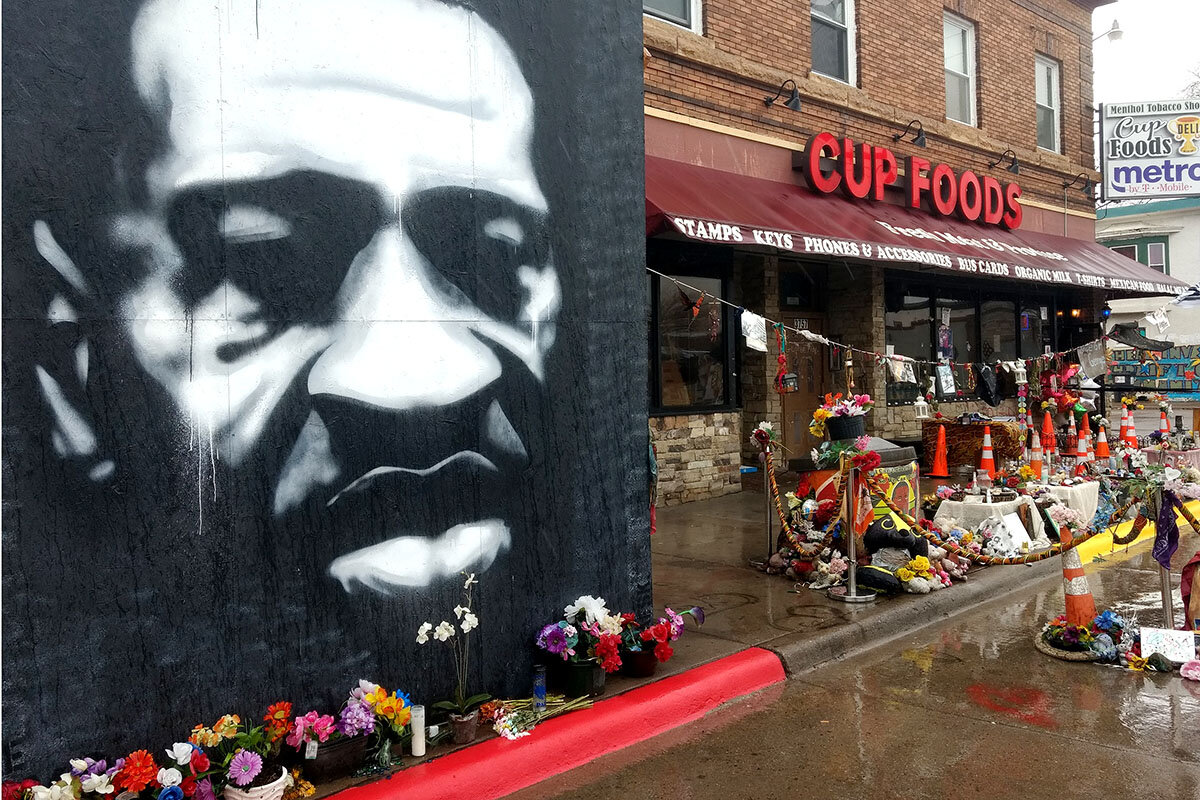
The displays of comity have since given way to a physical and emotional hollowness. In the four-block area now known as George Floyd Square, barricades impede vehicles from entering and activists occupy checkpoints to keep out police.
Officers bypass the so-called autonomous zone to avoid provoking confrontations. Their absence has coincided with a surge in gun violence in and around the square, including a fatal shooting earlier this month. The bloodshed has devastated the area’s shops and restaurants.
Dwight Alexander, who co-owns Smoke in the Pit, estimates business at his BBQ joint has plunged 75% in recent months. He has heard from longtime customers who fear walking into the square and from delivery drivers turned away at the barriers. He and other business owners accuse city officials and police of abandoning the neighborhood.
“I’ve been running this place for nine years. Cops used to come by to see how we were doing, but not a single person from the city has checked on me since all this started,” Mr. Alexander says. He thumped a fist against his chest. “They left me!”
Next door at Just Turkey, owner Sam Willis, who opened his restaurant in October, echoes the lament. He has talked with Mayor Jacob Frey and Police Chief Medaria Arradondo about the plight of businesses and residents – a screenshot on his phone shows him on a Zoom call with them – and has waited for the city to act. Both officials have announced that the autonomous zone will remain largely closed off until after Mr. Chauvin’s trial.
“Everybody here wants justice for George Floyd and wants this to be a place that always honors his memory,” says Mr. Willis, the father of four children. “But we also have families to support, and it’s a struggle right now.”

Turning aspirations into policy
The increase in violent crime in the neighborhoods around the square mirrors a citywide trend and overlaps with a steep loss in police personnel. Following last year’s upheaval over Mr. Floyd’s death – rioters torched the 3rd Precinct building and destroyed or damaged 1,500 businesses – the department endured a wave of retirements and resignations, and dozens of other officers have taken extended leaves.
The exodus has reduced the force by some 200 officers and prompted a lawsuit from a group of residents who seek to force the city to beef up the department to fight the rise in violence. Last month, the City Council approved a $6.4 million funding request from police officials to add dozens more officers, a decision that reform advocates cast as short-sighted.
“You shouldn’t have to choose between no police and violent police,” Ms. Levy Armstrong says. “There needs to be other ways to ensure community safety.”
Voters could have an opportunity to weigh alternatives this fall. A coalition of progressive groups has launched a petition drive for a ballot initiative that would replace the police force with a new Department of Public Safety by amending the city charter.
A similar amendment that could appear on the November ballot, proposed by Mr. Cunningham and two other council members, would include a law enforcement division within the new public safety agency. Both proposals treat violence prevention as a matter of public health and put forth a concept of community safety that relies less on force and more on trust.
“We can’t let everything we do be steeped in fear,” Mr. Bullock says. “That’s what has gotten us to this point with policing in America. We don’t have to dial 911 because somebody’s music is too loud.”
A convenience store clerk called police after Mr. Floyd tried to buy cigarettes with a fake $20 bill, setting in motion the arrest that led to his death. Mr. Cunningham, who has assured activists that the council will drop its proposal if the petition drive succeeds, wants residents to reimagine public safety as a kind of community contract that they keep with each other, rather than placing the entire onus on cops.
“People have been socially conditioned to believe that the police are the answer to almost every safety question that comes up in their lives,” he says. “That’s what we’re pushing back against.”
Racial justice advocates regard Mr. Chauvin’s trial as a chance to turn their aspirations into policy. Mike Griffin’s immersion in police reform began with the death of Jamar Clark six years ago. An electoral organizer with Community Change Action, a national advocacy group, he senses the momentum shifting at last.
“Progress happens slowly – that’s the history of this country,” he says. “But there’s not been a moment like this. George Floyd’s death fundamentally changed the conversation on police in this country. This is a 21st-century civil rights movement.”

A united front against China? Why that’s tricky for US and Europe.
The lines of the Cold War were clear. Today, with China, they’re blurred. Democracies want to challenge China politically but cooperate with it economically. It’s unclear how that might work.
- Quick Read
- Deep Read ( 7 Min. )
President Joe Biden sees pitting the democratic governance of the United States and its Western allies against the autocratic model of a rising China as this generation’s defining battle. And though it may sound as if it’s all about politics and values, it will be significantly intertwined with economics, experts say.
With the global economy inseparable from an assertive China, this intensifying relationship between politics and economics is going to complicate Mr. Biden’s vision of U.S. leadership.
“In Europe they’d like to keep things clean and neat, pursuing deeper trade with China while maintaining their principles and the norms of the international system, but they’re finding that things don’t stay neat and separate like that,” says Heather Conley at the Center for Strategic and International Studies in Washington.
Secretary of State Antony Blinken appeared to acknowledge Europe’s aversion to any generational confrontation with China when he reassured allies in Brussels last week they would not have to choose between the U.S. and China.
One factor that will determine the choices America’s allies make will be just how reliable a U.S. partner they see. Says Ms. Conley: “The allies can’t be expected to buy into a U.S.-led ideological battle if in Washington the pendulum is swinging every four years.”
A united front against China? Why that’s tricky for US and Europe.

The ideological battle that President Joe Biden sees pitting the democratic governance of the United States and its Western allies against the autocratic model of a rising China may sound as if it’s all about politics and values – and quite separate from global economics.
But unlike the Cold War of the last century, the 21st century’s autocracy-democracy confrontation will be significantly intertwined with economics, experts say.
With each country trying to pursue its own well-being in a global economy inseparable from an assertive and autocratic China, they add, this intensifying relationship between politics and economics is going to complicate Mr. Biden’s vision of the U.S. leading democracies to victory in what he characterizes as this generation’s defining battle.
“I predict to you [that] your children or grandchildren are going to be doing their doctoral thesis on the issue of who succeeded, autocracy or democracy, because that is what is at stake,” Mr. Biden replied to a question on competing with China at his first White House press conference on Thursday.
Adding that China’s heavy investment in new technologies and infrastructure both at home and abroad underscore how its intention is to “own” the future, Mr. Biden said it is up to the U.S. and allied democracies to demonstrate the utility and superiority of their system.
“We’ve got to prove democracy works,” Mr. Biden said.
By “we” Mr. Biden says he means America and its like-minded allies – a point he emphasized at his press conference by noting he would take up the autocracy-democracy challenge later the same day in a virtual summit with the leaders of the 27-member European Union.
Yet as willing as European allies may be to join with the U.S. when it means broadly asserting Western values, analysts of transatlantic relations say, there is still “wariness” about engaging in a Cold War-type ideological battle. That reluctance has been even stronger, they add, at any suggestion of extending the battle to the economic arena.
At least until very recently.
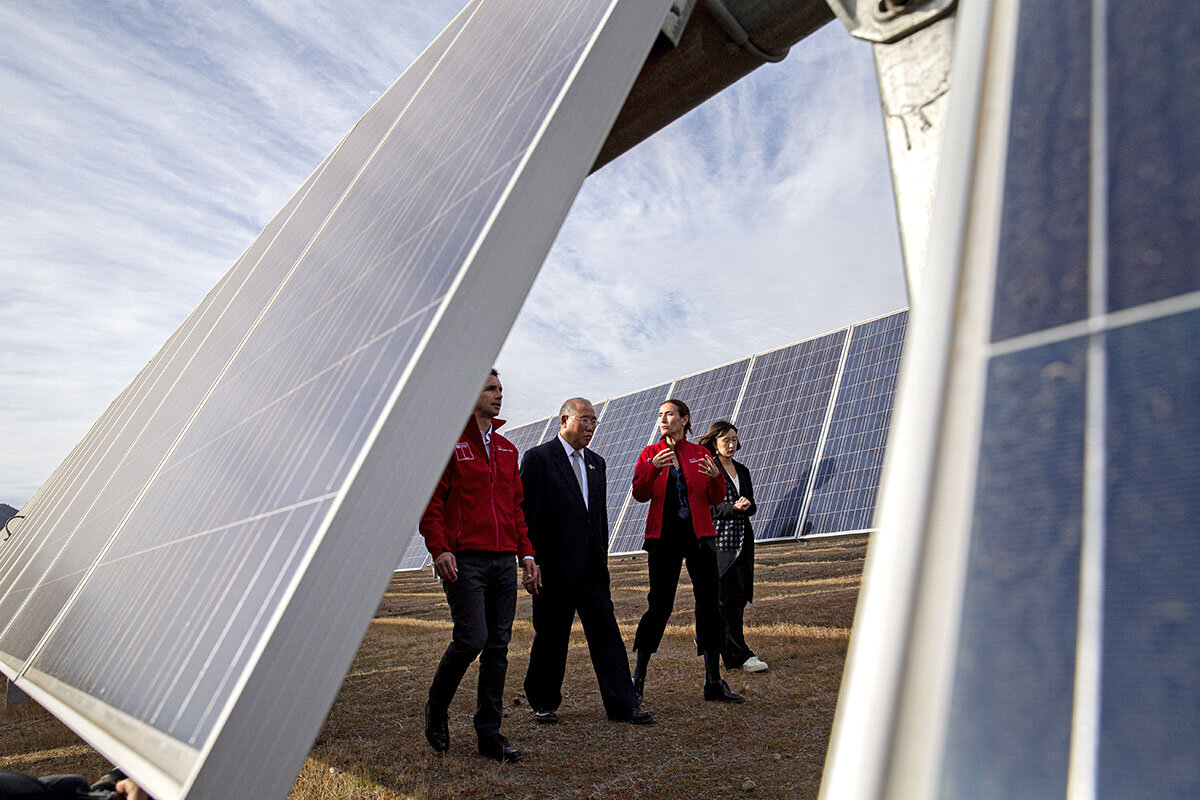
As China has shown a growing willingness to extend to Europe the brand of coercive economic diplomacy it has honed in less-powerful developing countries, European leaders and policymakers appear to be awakening to the realization that economics will be inseparable from the broader ideological struggle with an autocratic China.
“In Europe they’d like to keep things clean and neat, pursuing deeper trade with China while maintaining their principles and the norms of the international system, but they’re finding that things don’t stay neat and separate like that,” says Heather Conley, director of the Europe, Russia, and Eurasia Program at the Center for Strategic and International Studies in Washington.
“The economic is the geopolitical,” she adds, “and the geopolitical is the economic.”
Room to maneuver
America’s European allies are comfortable uniting to support Western principles such as democratic governance, others say, but far less enthusiastic about framing that promotion in the confrontational terms of a new cold war.
“On the European side, there’s a strong sense that the values piece of this question of dealing with China, and even some systemic reordering of relations based on values, is something that has to be signed up to … and coordinated” with the U.S., says Andrew Small, a senior transatlantic fellow in the Asia Program at the German Marshall Fund of the United States in Berlin.
“But there is a degree of trepidation about the framing of this, and caution on Europe’s part about anything that looks excessively confrontational,” he adds. The Europeans “are not willing to see this turn into another cold war, or something so adversarial that it rules out the two sides working together.”
Indeed, America’s European partners – and perhaps none more than Germany – resisted the growing suggestions over the four years of the Trump presidency of a dawning geopolitical battle that would once again put Europe at the center of a fight with powers like China and Russia.
“They have the memory of the Cold War and they don’t want to once again be the terrain where two great powers struggle for superiority,” says Ms. Conley. “They want to preserve the room to maneuver independently.”
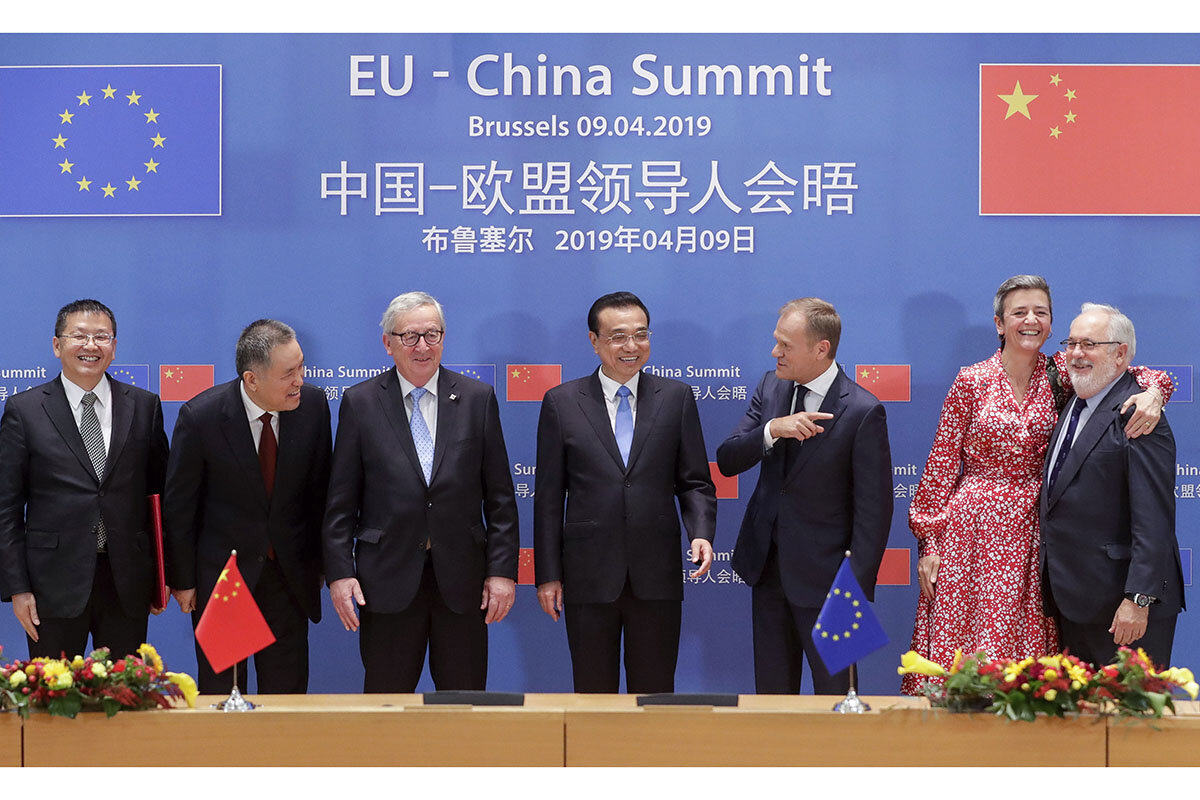
But at the same time, China’s recent willingness to employ its growing assertiveness toward Europe has prompted a growing openness to some European version of taking on China, Mr. Small says.
Until very recently, America’s European allies have been even less enthused about any actions that might upend the EU’s critical trading relations with China and economic ties more broadly.
Indeed, the EU in December finalized an as-yet unratified trade and investment deal with China, even as the Trump administration was imposing sanctions and other punitive measures on Beijing over everything from Hong Kong and treatment of China’s Uyghurs to alleged economic espionage in the U.S.
Blinken: No need to choose
Secretary of State Antony Blinken appeared to acknowledge Europe’s aversion to any generational confrontation with China – and the reality of a global economy where China is too big to simply ignore – when he reassured allies during a trip to Brussels last week that they would not have to choose between the U.S. and China.
The U.S. “won’t force allies into an ‘us-or-them’ choice with China,” Mr. Blinken said at NATO headquarters. Adding that “countries can work with China where possible” on issues such as climate change, he echoed the Biden administration’s “compete, cooperate where we can, and confront when we must” approach to China that broadly mirrors the EU’s own policy statement on China.
But European perceptions of China have shifted dramatically just in recent months, analysts say. And that shift has come not because there’s a new U.S. president calling for a robust transatlantic response to an autocratic China, but because China in recent weeks has shown Europe its authoritarian and imperious side.
For example, the Chinese government has sanctioned senior European parliamentarians and European nongovernmental organizations and think tanks that dared to condemn the use of forced labor in China’s western Xinjiang province to harvest cotton for garments and other products destined for Europe. Moreover, China has in recent days encouraged consumer boycotts of European fashion brands that voice concerns over reports of forced labor in cotton production in Xinjiang. It had previously threatened to retaliate against European companies in China that acted on human rights concerns raised by European governments.
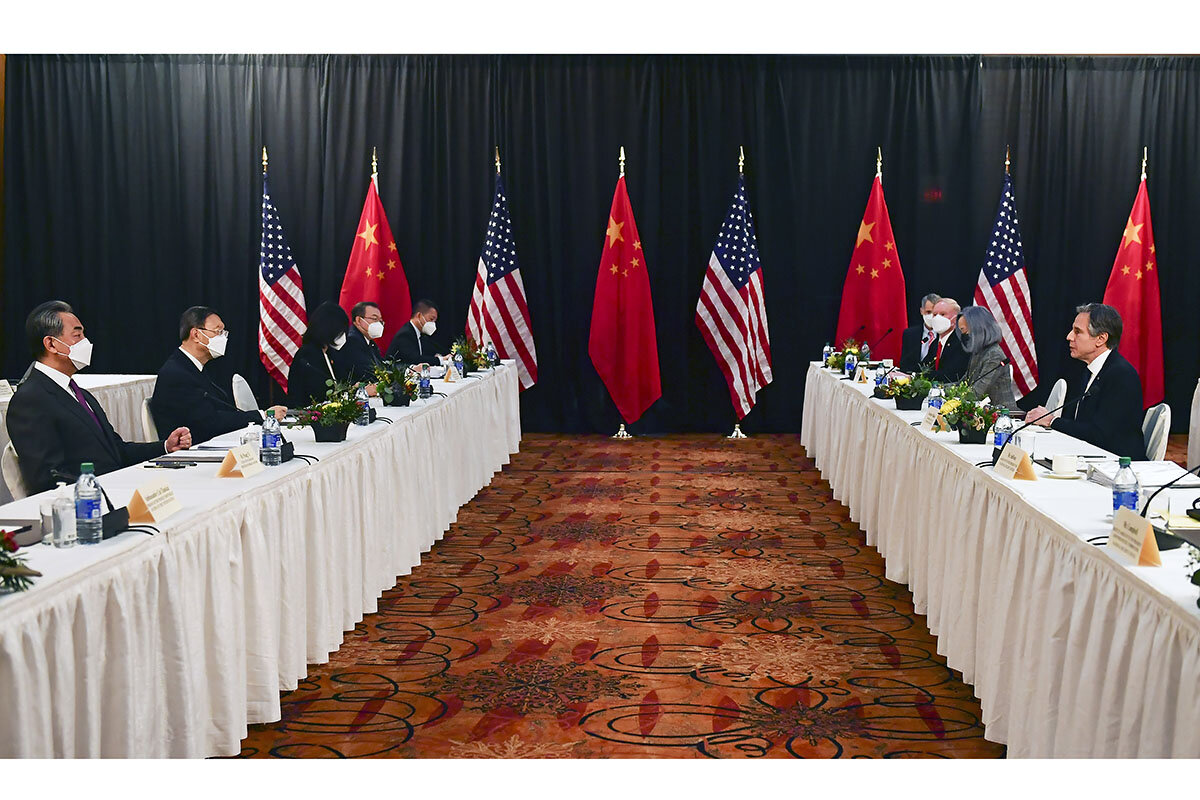
“More people are coming to realize they’re going to have to make some choices concerning China,” says Mr. Small, who is also associate senior policy fellow in Europe-China relations at the European Council on Foreign Relations in Brussels.
As China sanctions European officials and targets companies like the giant Swedish retailer H&M, “another question becomes, ‘Are these big choices really being placed on us by the U.S., or in fact more by China in the way it is framing these issues?’” he adds.
Reliable U.S. partner?
As China ramps up promotion of its development and governance model on a global scale, the question for some analysts is no longer if the Western democracies will unite to challenge China, but how extensive the united front will be.
The common action could remain relatively “thin,” Mr. Small says, limited to joint statements and gatherings of leaders to issue rhetorical support for values like universal human rights, democratic governance, and an open and transparent international trade regime.
Or it could “go deep,” he adds, which would mean much greater coordination among Western allies, including Japan, of supply chains; tech norms and development in areas like data sharing, artificial intelligence, and privacy; and perhaps even some alternative from the democracies to China’s Belt and Road infrastructure development initiative, as President Biden has proposed.
One factor that analysts say will determine the choices America’s allies make will be just how reliable a partner they see in Washington, which after decades of steadfast leadership has more recently seesawed between internationalist and more nationalist policies and outlooks.
The Western democracies’ battle with China “is going to require some choices in Europe, but it will also require a steadiness from the U.S.,” says Ms. Conley. “The allies can’t be expected to buy into a U.S.-led ideological battle if in Washington the pendulum is swinging every four years.”

Listen
On the clock: How the clock became king
Clocks do more than give us a way to coordinate with each other. Timepieces are also tools of control and of liberation. This is the latest installment in our series on time.
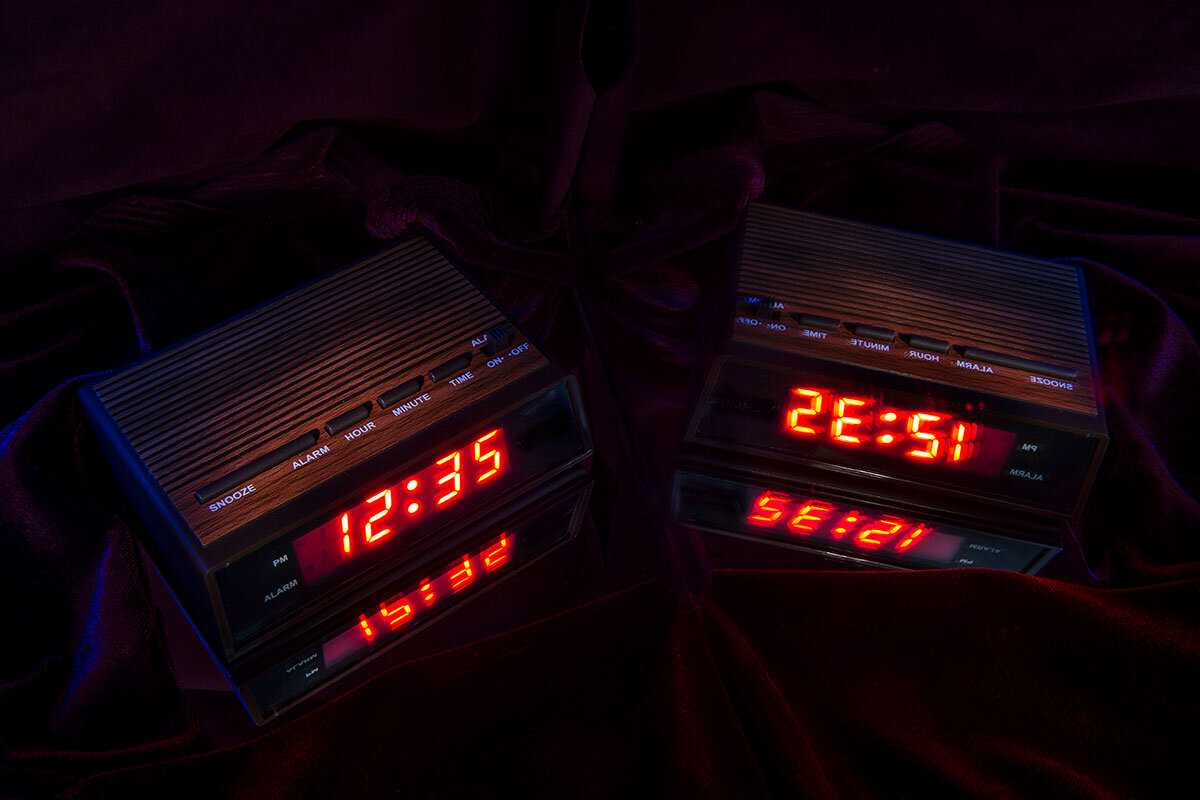
At 10 years old, Madeline was becoming a little obsessed with her alarm clock. So her mom took it away.
But Madeline isn’t alone. Maybe you just glanced at a timepiece on your wall, your wrist, or your car dashboard. Or maybe you just checked the time on your computer or your phone, as it queries an internet server synced with a global network of 400 atomic clocks.
We’re all glued to the clock, in one way or another.
In Episode 4 of the Monitor’s six-part podcast series, “It’s About Time,” hosts Rebecca Asoulin and Eoin O’Carroll look at how the clock became king – and how it shifted Western culture, for better or worse.
Timekeeping historian Alexis McCrossen traces that history. Some scholars, she says, viewed clock time as “an oppressive force that drained people of their vitality, that monetized time, and that gave those with power much more power.” But timekeepers also allow people to organize their lives and build a society. “If I wanted to live as a hermit, I can live without clocks and watches,” she says.
For Dawna Ballard, a communications expert who studies time and work, the key is in recognizing when to rely on clocks, and when to go outside clock time to protect the things we value.
“Time isn’t a clock,” Dr. Ballard says. “Time is an agreement. We decide what time is.”
This story was designed to be heard. We strongly encourage you to experience it with your ears (audio player below), but we understand that is not an option for everybody. A transcript is available here.
It's About Time: On the Clock

Germany has money. Why don’t its schools have computers?
Germany’s classrooms are oddly old-school when it comes to technology. But the past year has dramatically shown many teachers how technology can shape education for the better.

- Quick Read
- Deep Read ( 6 Min. )
Germany may be Europe’s wealthiest country, but you wouldn’t necessarily know it from its classrooms. Only 1 in 3 students has access to online learning platforms. It’s only with the pandemic that a public spotlight has been turned on the effects of abysmally poor digitization levels, and the accompanying lockdown has prompted a radical rethinking of the need for digital infrastructure and teacher training.
The federal government’s €5 billion ($5.9 billion) Digital Pact for Schools passed in 2019 focused on digital equipment. But through mid-2020 only a fraction – about €15 million – of a now €6.5 billion committed to Germany’s digitization effort has been distributed across the country’s 16 states, which oversee education. And infrastructure is only one part of what’s needed. Revamping pedagogy and training teachers are also important pillars.
“We Germans are programmed to have an organized system that constantly thinks in hierarchy, but we forget the world has moved forward at great speed,” says Matthias Kostrzewa of Ruhr University’s Professional School of Education. The pandemic “has been a magnifying glass to show the problems we had not just in schools, but all areas of society. And it’s accelerated the bureaucratic work [of digitization].”
Germany has money. Why don’t its schools have computers?

Germany may be Europe’s wealthiest country, but you wouldn’t necessarily know it from its classrooms. Take those in Bremen, where Tim Kantereit has been working hectically to introduce digital tools and concepts to his educational colleagues.
The former math and geography teacher found himself “always five to six years ahead” of the curve in Germany, where computers, software, and other technology are sorely lacking in schools.
“I’ve fought with teachers who question why digitization is the future, and why it even has to be considered,” says Mr. Kantereit, who has trained teachers for the last seven years of a two-decade career in education. “So much discussion about why everything has to be digital.”
Only 1 in 3 students has access to online learning platforms, compared with more than half in other countries across the Organization for Economic Cooperation and Development. A €5 billion ($5.9 billion) federal digitization plan, the Digital Pact for Schools, passed two years ago has been slow to pick up steam. It’s only with the pandemic that a public spotlight has been turned on the effects of abysmally poor digitization levels, and the accompanying lockdown has prompted a radical rethinking of the need for digital infrastructure and teacher training.
“We Germans are programmed to have an organized system that constantly thinks in hierarchy, but we forget the world has moved forward at great speed,” says Matthias Kostrzewa, digitization officer at Ruhr University’s Professional School of Education in Bochum. The pandemic “has been a magnifying glass to show the problems we had not just in schools, but all areas of society. And it’s accelerated the bureaucratic work [of digitization].”
“Oven vegetables”
When the pandemic hit and schools shut down in Germany, it became very quickly apparent that not every child had access to a tablet or smartphone, much less a Wi-Fi connection. By last summer, the government had dedicated €500 million to digital hardware, but the flowchart for the funding was so complex – feds to state to schools to families – that it wasn’t clear students were getting the devices quickly.
“That’s why we lobbied that families who already get social services should apply for money from employment offices directly and buy the laptop themselves,” says child social security expert Jana Liebert.
It’s these kinds of bureaucratic hurdles, made ever more obvious amid the pandemic, that have tripped up Germany’s massive education digitization effort in normal times.
The federal government’s Digital Pact for Schools focused on digital equipment, but infrastructure is only one part of what’s needed. Revamping pedagogy and training teachers are also important pillars.
Yet how does one start bringing the education system into the modern era, when the federal government has the funding, yet education is administered by each of Germany’s 16 states, with many schools given latitude on how to implement initiatives?
Further, there’s confusion around what exactly digitization is. “My example is oven vegetables,” says Mr. Kostrzewa, the digitization officer. “If we order this at a restaurant, we all have an idea of what it might be, but it’s not the same as what the restaurant imagines.”
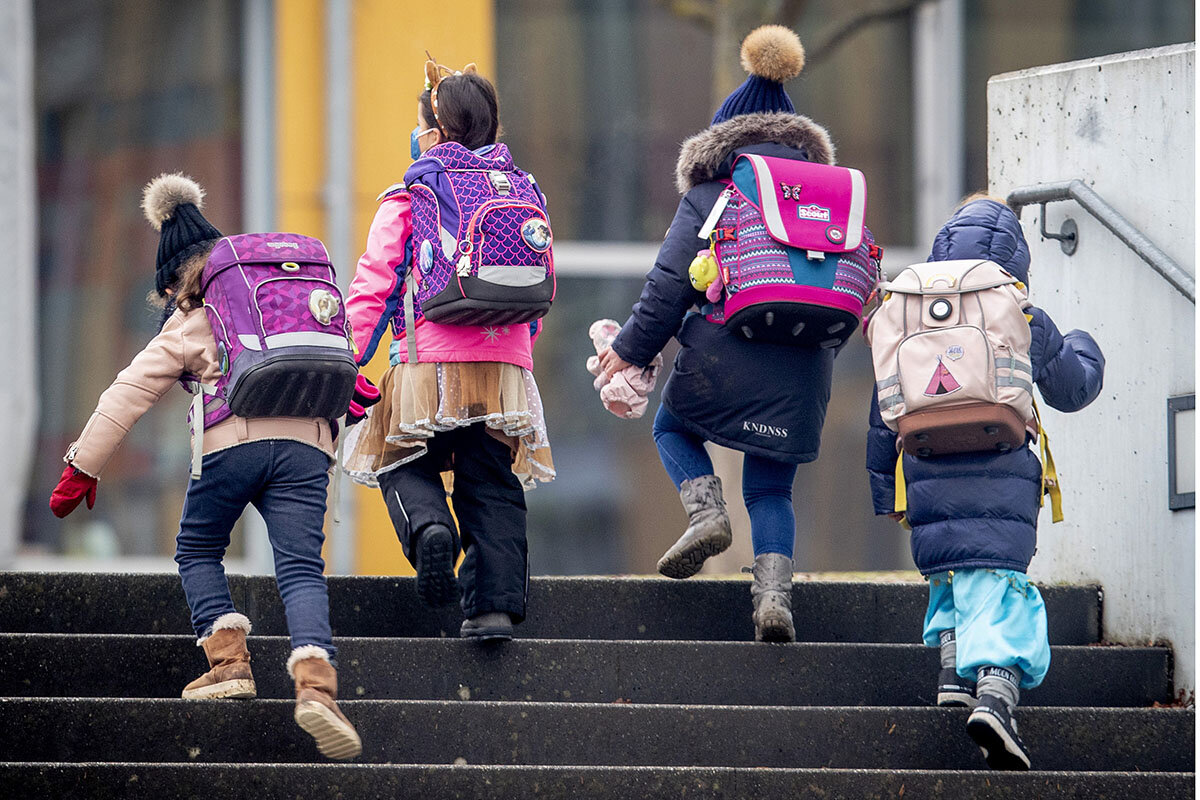
Digitization can mean technical devices and Wi-Fi, which are in short supply still in rural districts, but it can also encompass the platforms required for distance learning, as well as utopian or dystopian discussions such as, Do we even need teachers in the future?
Through mid-2020 only a fraction – about €15 million – of a now €6.5 billion committed to Germany’s digitization effort has been distributed across the 16 states, which oversee education. Approaches have depended heavily on each region, whereas cities also have varying approaches, from soup-to-nuts revamps of existing curricula to simply purchasing 27,000 digital devices as Cologne has.
What’s clear is that the pandemic has illustrated the urgent need for digitization, which has helped speed up the bureaucracy around the process.
“Surely the pandemic has accelerated the bureaucratic work of digitization, and also highlighted the problems of inequality,” says Mr. Kostrzewa. “In distance learning, a lot depends on how much parents can support the child. When corona is over we will be longing for normality, but I hope we remember the good parts of the development and take those aspects with us into the future.”
What does digitization mean?
When digitization works, it’s a long process that’s baked into the fabric of a school community.
Micha Pallesche, a principal in the midsized southwestern city of Karlsruhe, remembers when his school first tried to “digitize” teaching and learning. “For the schoolbooks, they just made the books into PDFs,” says Mr. Pallesche, principal of Ernst Reuter Community School. “It was the exact same thing. Only a PDF.”
“The question that became important is to think about what ‘digitization’ actually means,” he adds.
That question prompted a long journey, started six years ago, to begin “digitization” from scratch. “What’s outside of what people think digitization is? It’s not just about putting a smart [whiteboard] in the classroom,” says Mr. Pallesche.
The school’s transformation started when its home state of Baden-Württemberg voted to support alternative “community schools.” The city of Karlsruhe approached Ernst Reuter Community School and asked if it would be a pilot project. Financing came from the local school board, with other funds coming from the federal Digital Pact, grants and prize money, and donations from corporate foundations. (A pandemic-related government payout also helped buy a few dozen iPads.)
Then, over six years, school administrators tapped a community brainstorming effort, which brought in different viewpoints and expertise. Students were central to decision-making, with parents and teachers also involved.
What resulted is a school that now deploys, yes, whiteboards, but has also completely transformed teaching and learning processes. Funding helped purchase everything from iPads to video production software to 3D printers. It also overhauled teacher training.
Flipped classrooms
One of the school’s proudest transformations is what Mr. Pallesche calls the double “flipping” of the flipped classroom.
A flipped or inverted classroom requires students to watch content videos prior to class. Then students come to class already briefed, so the teacher can use in-person time to discuss and mine new depths understanding, rather than waste time introducing basic material.
Here, the school innovates further. It flips the “flipped” classroom once more to make the students the teachers. Students create videos and write books, and become producers of their own content. “They use the four C’s: create, collaborate, communicate, be critical,” says Mr. Pallesche. “They have to understand the topic to be able to teach it. They’re learning much more sustainably this way.”
The pandemic prompted the school to further innovate. By the second lockdown, teachers began experimenting with ways to connect subjects such as chemistry and biology along a single theme, such as energy. “We are networking these subjects now,” says Mr. Pallesche. “The world outside isn’t divided into subjects – it’s all connected.”
Ernst Reuter Community School is now Germany’s first “smart school,” even though it’s housed in an old building from the 1960s. “People think they need the best infrastructure, but that’s not true. We just used these rooms and space differently,” says Mr. Pallesche.
The average German public school has a long way to go, though the pandemic has given digitization a heightened sense of urgency. “These ideas I tried to implement a couple of years ago are now widespread in Bremen,” says Mr. Kantereit, the teacher trainer and author of “Hybrid Teaching 101.”
One thing Mr. Kostrzewa, the digitization officer, hopes will be reexamined in the future is society’s obsession with having a daily presence in school. Maybe three days a week is enough. Politicians also desire too much control over change, he says, and should perhaps embrace the fact that reform can be overwhelming.
Longer term, the education system is moving in the right direction, says psychologist Thilo Hartmann. “That’s a positive thing, because digitization can help support students who are chronically ill or otherwise challenged. ... It allows a flexible education.”

In Pictures
Penn Station upgrade was decades in the making
In New York’s new Moynihan Train Hall, travelers find splendor, whimsy, and even a bit of awe, adding credence to the idea that the journey can be as inspiring as the destination.

-
Connie Foong Staff writer
Penn Station upgrade was decades in the making
Addisalem Zimbi has worked at a food kiosk in the Moynihan Train Hall every morning since it opened on Jan. 1. Three months later, she is still awed by its architecture. And she’s not the only one. Travelers emerge into the sun-filled atrium with surprised looks. “Some people didn’t even know about it. They are shocked and are like, ‘Where am I?’” says Ms. Zimbi, laughing.
The idea to transform the mail-sorting hall of the James A. Farley Post Office, originally designed by McKim, Mead & White in 1914, into an extension of the overcrowded Pennsylvania Station was first proposed by U.S. Sen. Daniel Patrick Moynihan in the 1990s. After years of wrangling, development began in 2016. It opened ahead of schedule, in the middle of a pandemic, to a subdued city.
The $1.6 billion hall, designed by Skidmore, Owings & Merrill, is a marvel of steel, glass, and marble, complete with art installations. A stained-glass triptych by Kehinde Wiley, which features break dancers leaping over the heads of unsuspecting passersby below, evokes Michelangelo’s “The Creation of Adam.” “The Hive,” an upside-down cityscape by Elmgreen & Dragset, is equally arresting. A retro-style waiting area, with cozy curved booths, features nine reconstructed photographs of the original Penn Station (demolished in the 1960s) by Stan Douglas. And the centerpiece: the sun shining through a 92-foot-high vaulted skylight, glinting off century-old steel trusses.
For all its splendor, the facility does not yet solve Penn Station’s overcrowding in normal times. For now, it serves only Amtrak and Long Island Rail Road passengers.
Yourina Janvier, a security guard, appreciates the hall’s beauty, but hopes for more. “If they can do this here, then they can do it over there too,” she says, gesturing toward the busier side of Penn Station.
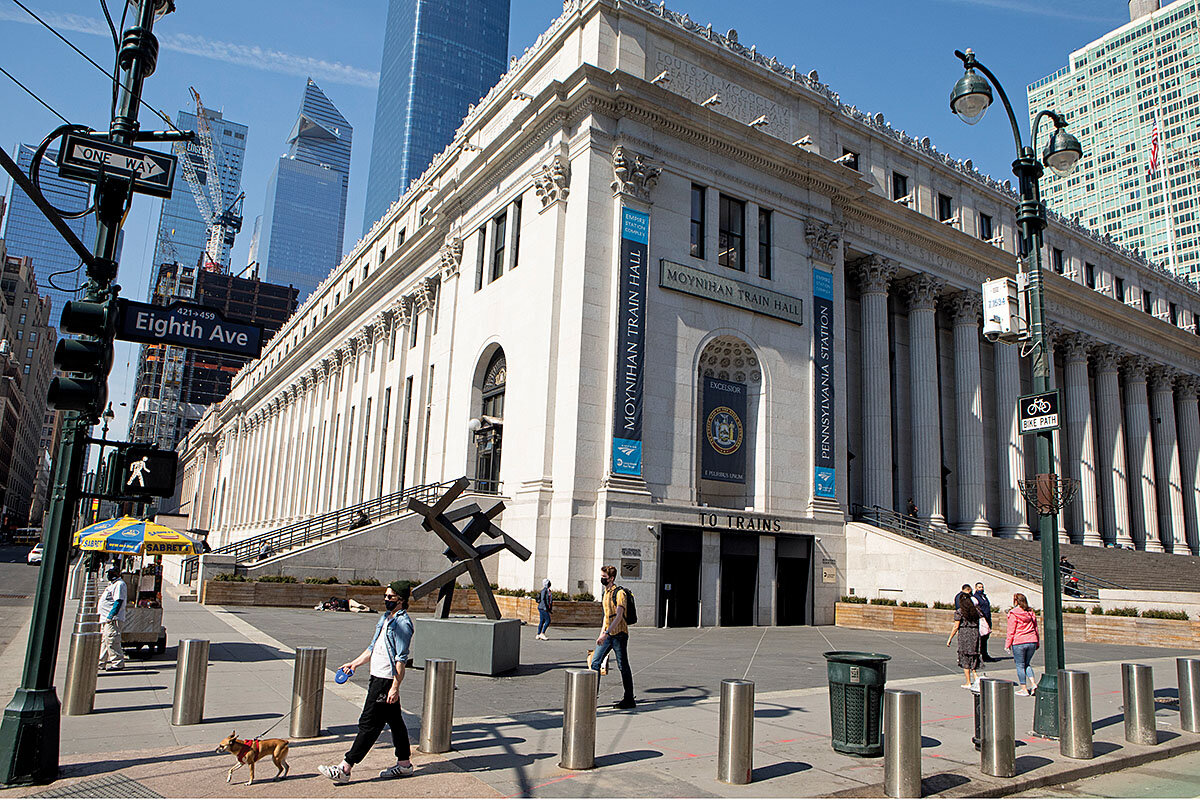
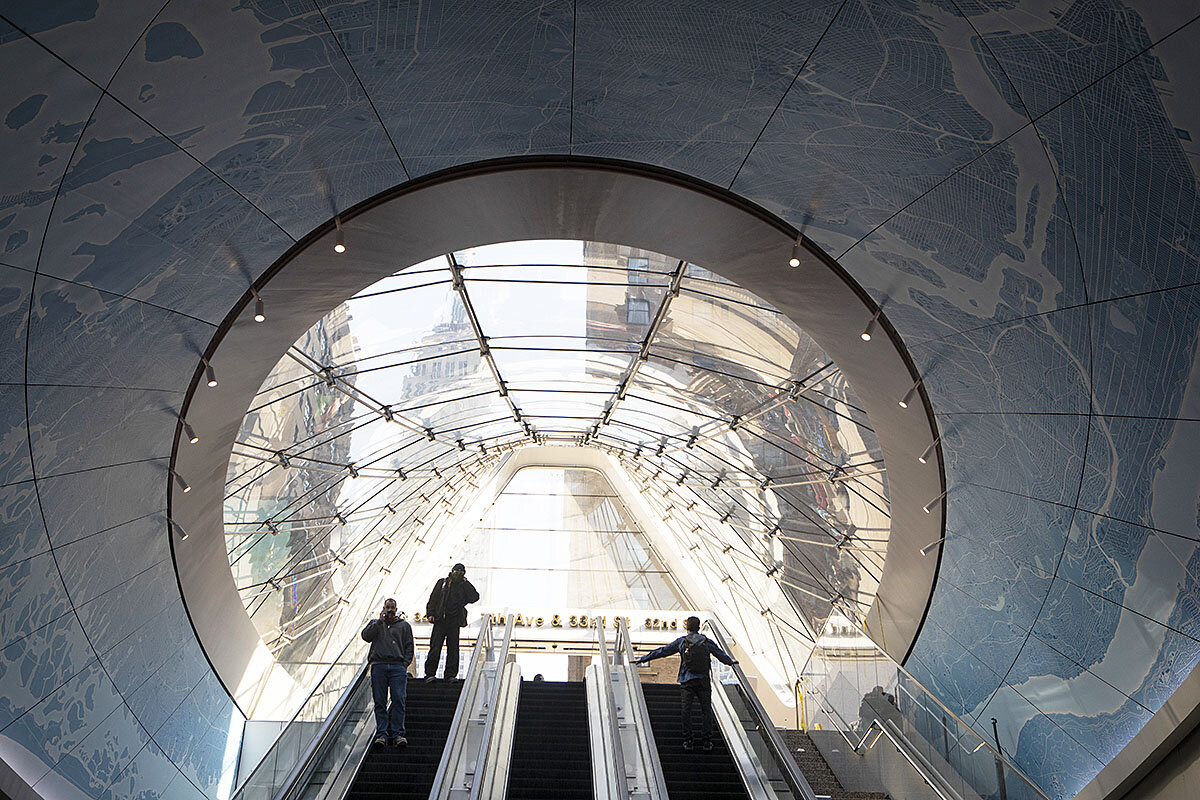
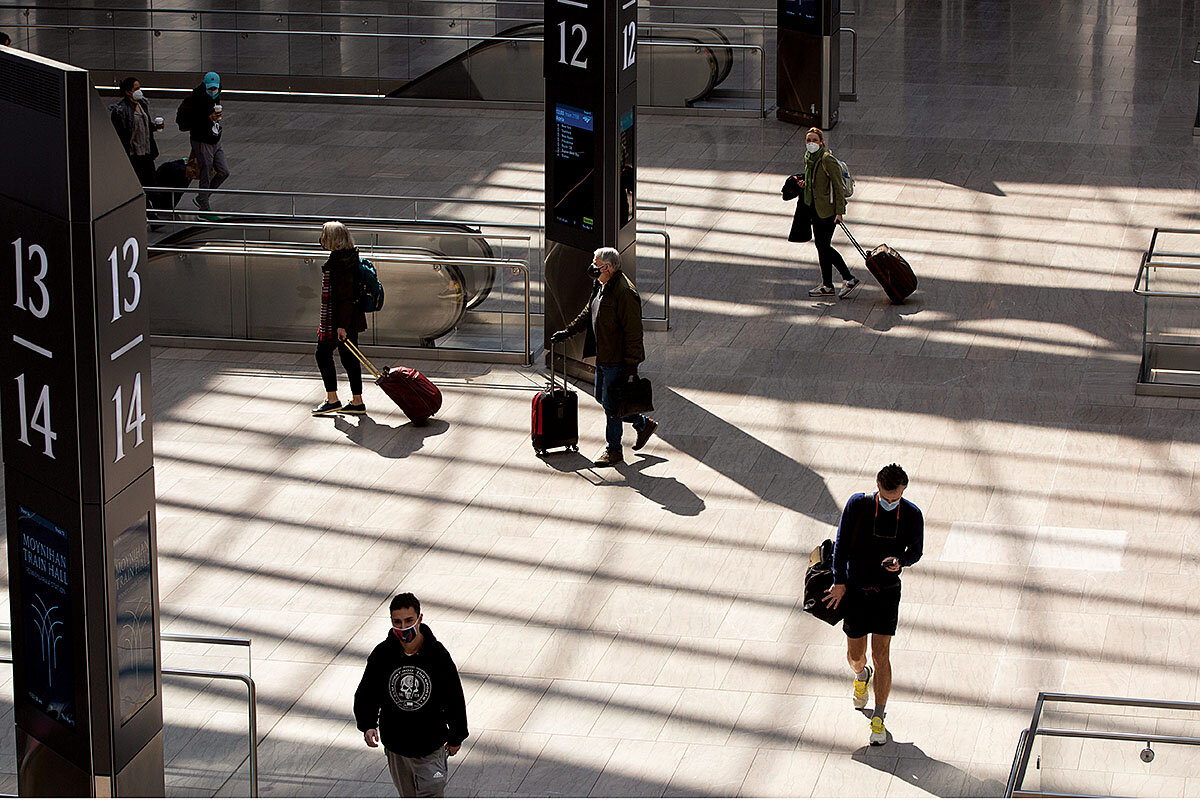
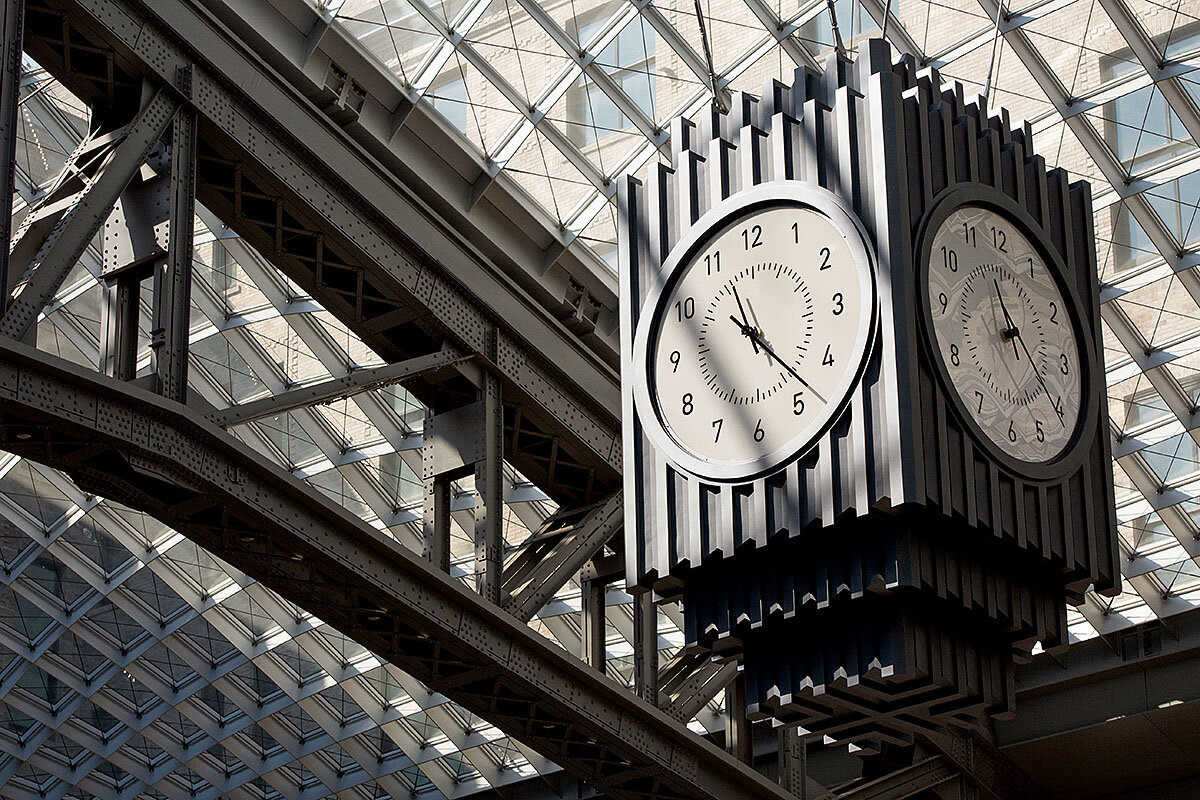
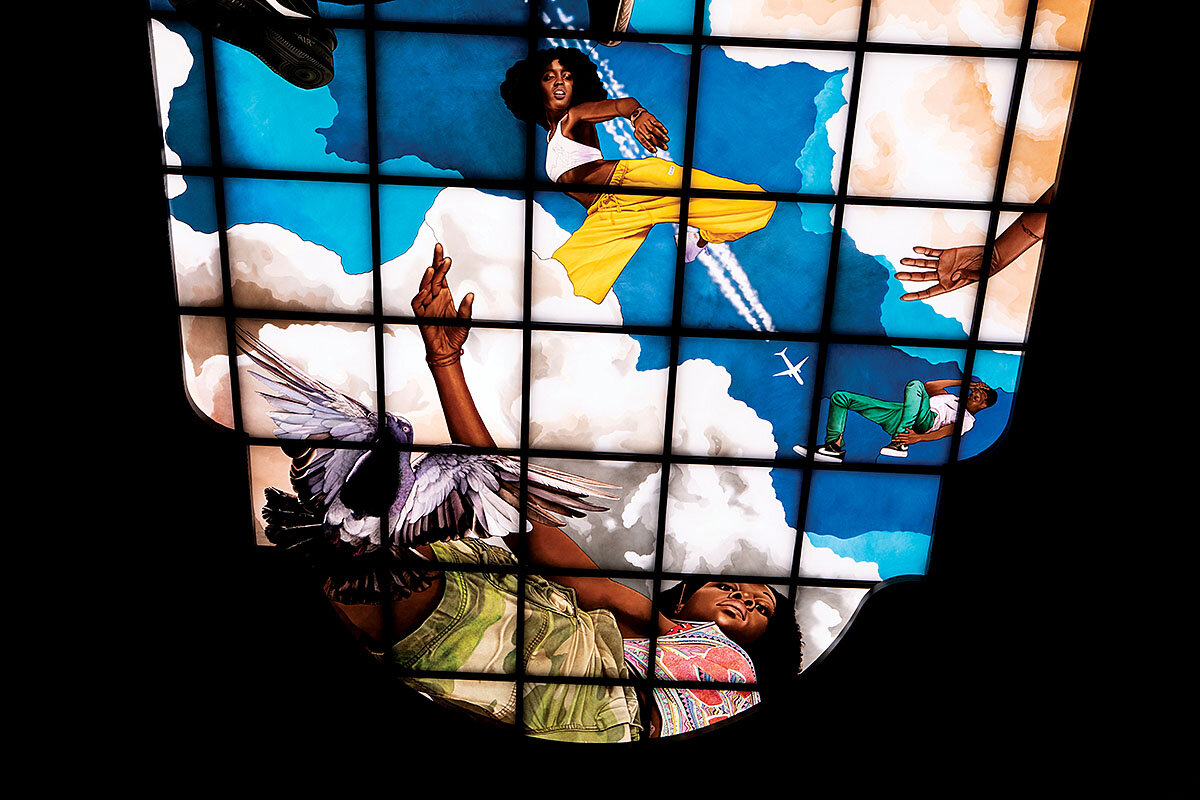
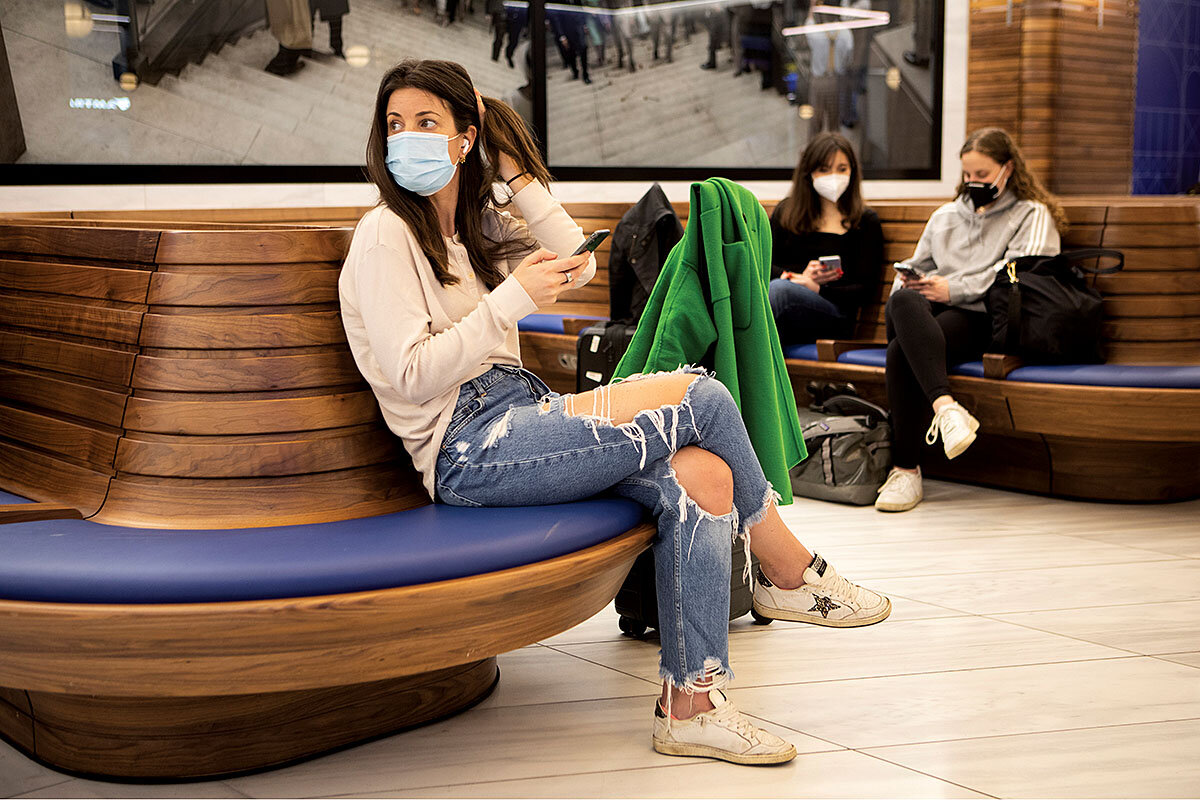
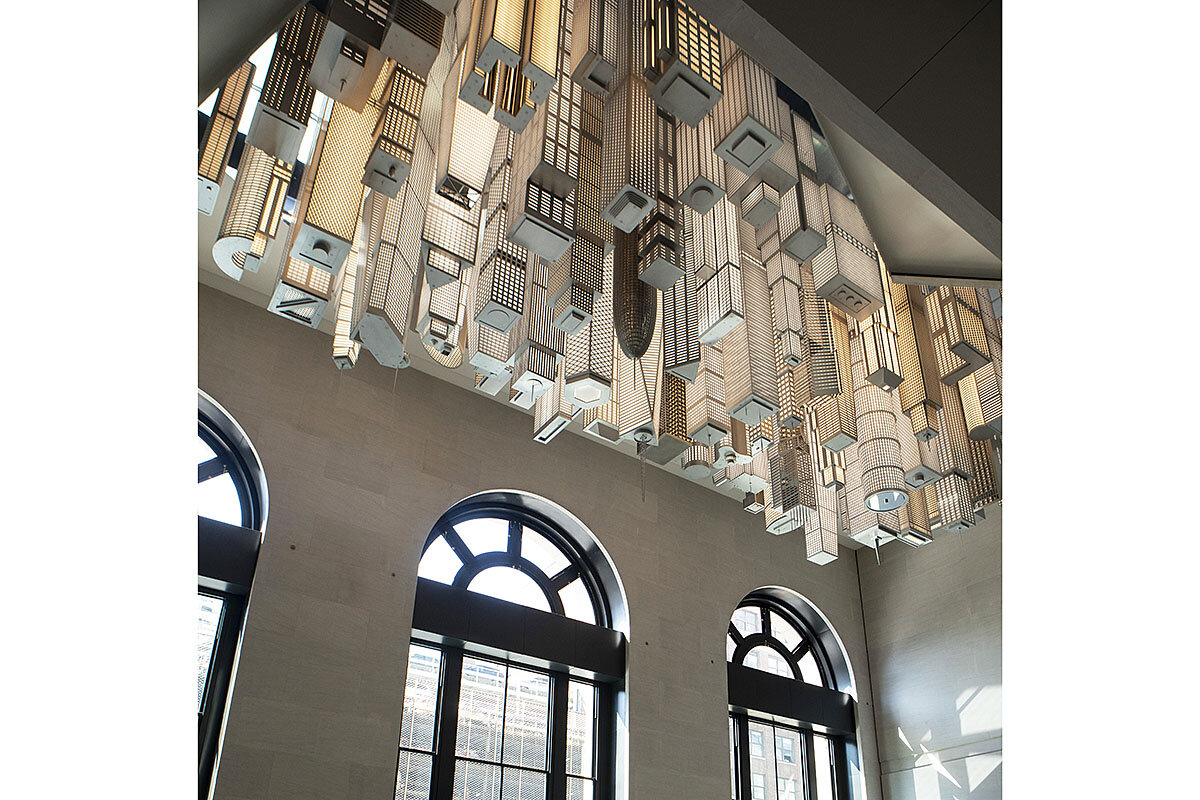
We’ve been experimenting with the presentation of our photo essays online and in the Monitor Daily. What do you think? Share feedback with the photo team at csmphotoeditors@csmonitor.com.
Other headline stories we’re watching
(Get live updates throughout the day.)The Monitor's View
When equality outmatches loathing
- Quick Read
- Deep Read ( 3 Min. )
-
By the Monitor's Editorial Board
Since an inconclusive election March 23 for Israel’s parliament, a few Jewish politicians have been courting unlikely allies to help them form a majority coalition in the Knesset: two parties that represent Arab Israelis, who make up a fifth of the country’s citizens. This has raised the hope of an Arab party being part of an Israeli government for the first time, something that nearly half of Jewish Israelis now support.
While far from certain, that prospect shows how peace in the Middle East sometimes comes through person-to-person engagement, or when equality outmatches religion and ethnicity.
Israel’s post-election horse-trading between Arab and Jewish politicians comes as the country is enjoying a new warmth in relations with more Arab states. In addition, peace builders between Palestinians and Israelis received a big boost in December when the U.S. Congress passed a bill that will provide $250 million to fund such reconciliation initiatives.
Cultivating trust in daily life between people helps build interdependence and a reservoir of mutual support. If the next Israeli government can reflect that sort of trust, it can happen in the rest of the Middle East.
When equality outmatches loathing
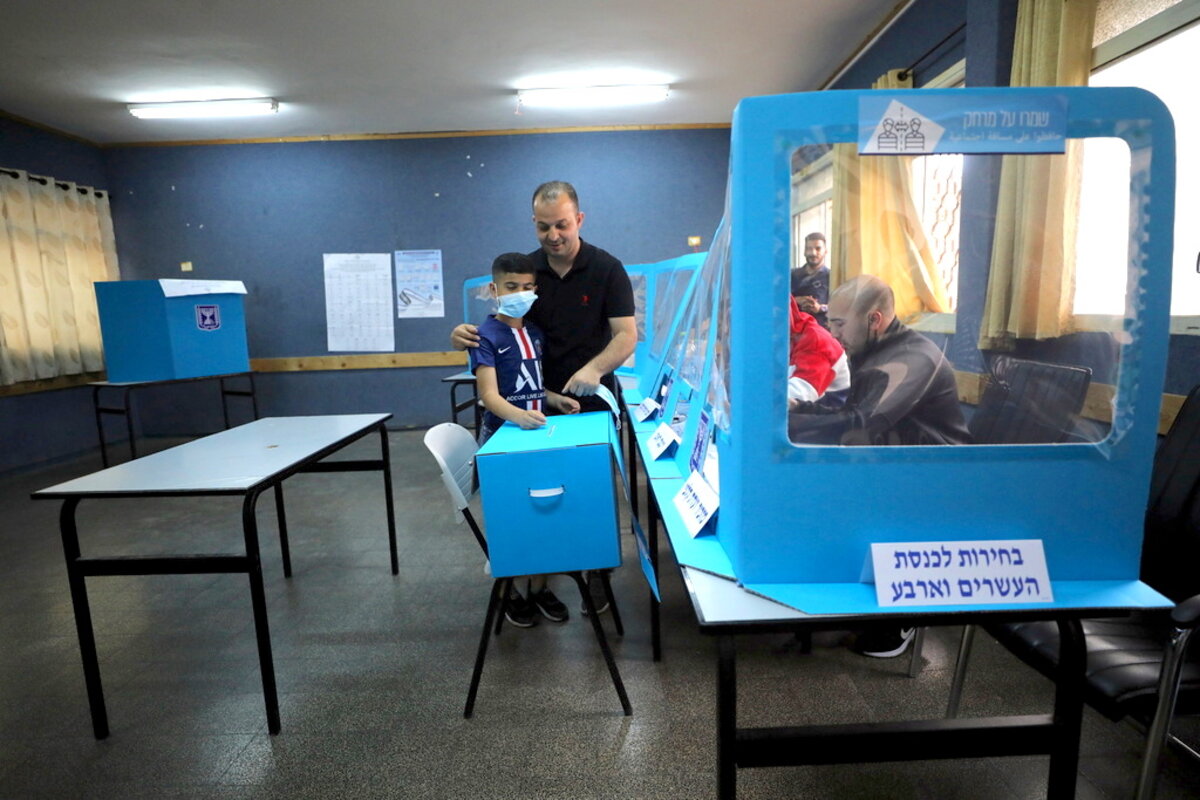
Since an inconclusive election March 23 for Israel’s parliament, a few Jewish politicians have been courting unlikely allies to help them form a majority coalition in the Knesset: two parties that represent Arab Israelis, who make up a fifth of the country’s citizens. This has raised the hope of an Arab party being part of an Israeli government for the first time, something that nearly half of Jewish Israelis now support.
While far from certain, that prospect shows how peace in the Middle East sometimes comes through deep person-to-person engagement, or when equality outmatches religion and ethnicity.
Israel’s post-election horse-trading between Arab and Jewish politicians comes as the country is enjoying a new warmth in relations with more Arab states. Under an agreement last fall known as the Abraham Accords, the United Arab Emirates, Bahrain, Morocco, and perhaps Sudan are normalizing ties with Israel. This is leading to a greater exchange of people, ideas, capital, and technology.
That sort of practical interaction is already reflected among Israeli Arabs, who largely vote for leaders who promise better policing to reduce crime and more access to jobs. It is also reflected in Prime Minister Benjamin Netanyahu’s newfound attempt to win over Arab voters in order to keep his job. During a campaign stop in largely Arab Nazareth, he promised a “new era of Jewish-Arab relations ... an age of honor and equality, an age of opportunities, and an age of power.”
The most urgent need for closer ties is between Israelis and Palestinians in Gaza and the West Bank. At an official level, the decadeslong peace process between them is stagnant. That may change in coming months as Palestinians hold their first elections in 15 years. Half of the young population has never voted and will be able to finally cast ballots for their leaders, a democratic experience that may help instill a greater notion of equality.
Much of the work to reconcile Israel and the Palestinians has been done by private peacemaking groups. They have set up youth sports clubs, tech training, and other programs that mix the two peoples. These peace builders received a big boost in December when the U.S. Congress passed a bipartisan bill that will provide $250 million over five years to fund such reconciliation initiatives. The measure is similar to a fund set up in the 1980s to promote dialogue between people in Northern Ireland. That effort helped lead to a later peace accord.
Might the new U.S. funding do the same for Israelis and Palestinians?
“Hard-wired ideas about identity or enmity with your neighbors, you can’t fix them quickly – it needs to be a sustained, real engagement,” John Lyndon, executive director of the Alliance for Middle East Peace, told The Times of Israel. “It requires deep engagement and taking seriously people’s identity, and their red lines – and to understand why people are saying what they’re saying.” His alliance represents some 130 peace-building groups working with Israelis and Palestinians.
The catalysts for peace are not always a result of diplomacy or a military truce. Cultivating trust in daily life between people helps build interdependence and a reservoir of mutual support. If the next Israeli government can reflect that sort of trust, it can happen in the rest of the Middle East.

A Christian Science Perspective
Each weekday, the Monitor includes one clearly labeled religious article offering spiritual insight on contemporary issues, including the news. The publication – in its various forms – is produced for anyone who cares about the progress of the human endeavor around the world and seeks news reported with compassion, intelligence, and an essentially constructive lens. For many, that caring has religious roots. For many, it does not. The Monitor has always embraced both audiences. The Monitor is owned by a church – The First Church of Christ, Scientist, in Boston – whose founder was concerned with both the state of the world and the quality of available news.
Is joy OK during difficult times?
- Quick Read
- Read or Listen ( 3 Min. )
-
By Kim Hedge
Sometimes life just doesn’t seem like a laughing matter. But opening our hearts to God empowers us to feel the God-given hope and joy that uplift and heal.
Is joy OK during difficult times?
I watched my young nephew running around with my dog as they chased each other in the park. I couldn’t help but smile and laugh at the sounds of his giggles and squeals of sheer delight when he called to my dog to chase him and she obliged and bounded off after him. In that moment, with the fresh autumn air and the red and gold leaves on the trees, everything seemed perfect and the world felt full of love and life and joy.
Later that day after he left, I was catching up on the news. It seemed as though the world was in a pretty serious state. I found myself wondering how I could, in a single day, have such a beautiful, joy-filled moment and then feel such frustration and sadness at the state of things. It can sometimes feel as though our health, government, economy, basic human decency, and the fabric of our communities are all hanging in the balance. None of this seems like a laughing matter.
So, given all that, is it OK to laugh and feel joy at times like this?
I recently came across a story about Holocaust survivor Ernie Gross, who maintains that humor and hope are what got him through that horrific experience where he lost nearly everything, including most of his family members. One night while in a concentration camp, he had a dream that he was in a room with God, who sneezed, and Mr. Gross didn’t know what to say to Him. He found it humorous, and he’d regularly think back to that moment in the dream and it would make him laugh. Mr. Gross’s inspiring story points to the value of laughter and even joy during times of suffering (see Marion Callahan and Melina Walling, “Holocaust survivor shares message of hope, humor, forgiveness, 75 years after liberation,” Bucks County Courier Times, Sept. 28, 2020).
Christian Science explains that joy is a quality of Spirit, another name for God, as it says in the Gospel of John: “God is a Spirit: and they that worship him must worship him in spirit and in truth” (4:24). So to worship God in spirit, to me, means we must also express the Spirit that is God. And as we are created in God’s image (see Genesis 1:26, 27), we must be like God. Therefore a spirit of joy is inherent within us.
This kind of spiritual joy has the power of God behind it. It is the light that shines within us, even in the dark, to help light the way for ourselves and others. Jesus told us to let our light shine, not for our own glory, but to glorify God. Letting our God-given light shine and expressing joy even during trying times can help others find their own joy, too. There’s a hymn in the “Christian Science Hymnal: Hymns 430-603” that states, “We can share Your happiness, / Share Your joy and spend it freely” (Elizabeth C. Adams, alt., No. 474). This is not to say we should be insensitive or uncompassionate when others are struggling. Rather, we can find opportunities to uplift others. Even in the midst of what may seem like the darkest of times, God’s loving presence is right with us, here for us to feel when we open our hearts to it. And in that presence of the Divine, we can find peace and joy and hope, which we can hold on to to lift ourselves up as well as those around us.
Since joy is inherent within us, nothing can hamper our ability to feel and express this quality, which can also bring hope and healing. In the Bible, the Psalmist says, “In thy [God’s] presence is fulness of joy” (Psalms 16:11).
Mary Baker Eddy, founder of The Christian Science Monitor, puts it this way in a poem:
Hope happifies life, at the altar or bower,
And loosens the fetters of pride and of power;
It comes through our tears, as the soft summer rain,
To beautify, bless, and make joyful again.
(“Miscellaneous Writings 1883-1896,” p. 394)
When we open our hearts to God, we can feel the presence of God’s love right where we are. This brings hope and joy that heal.

A message of love
No age limit on learning
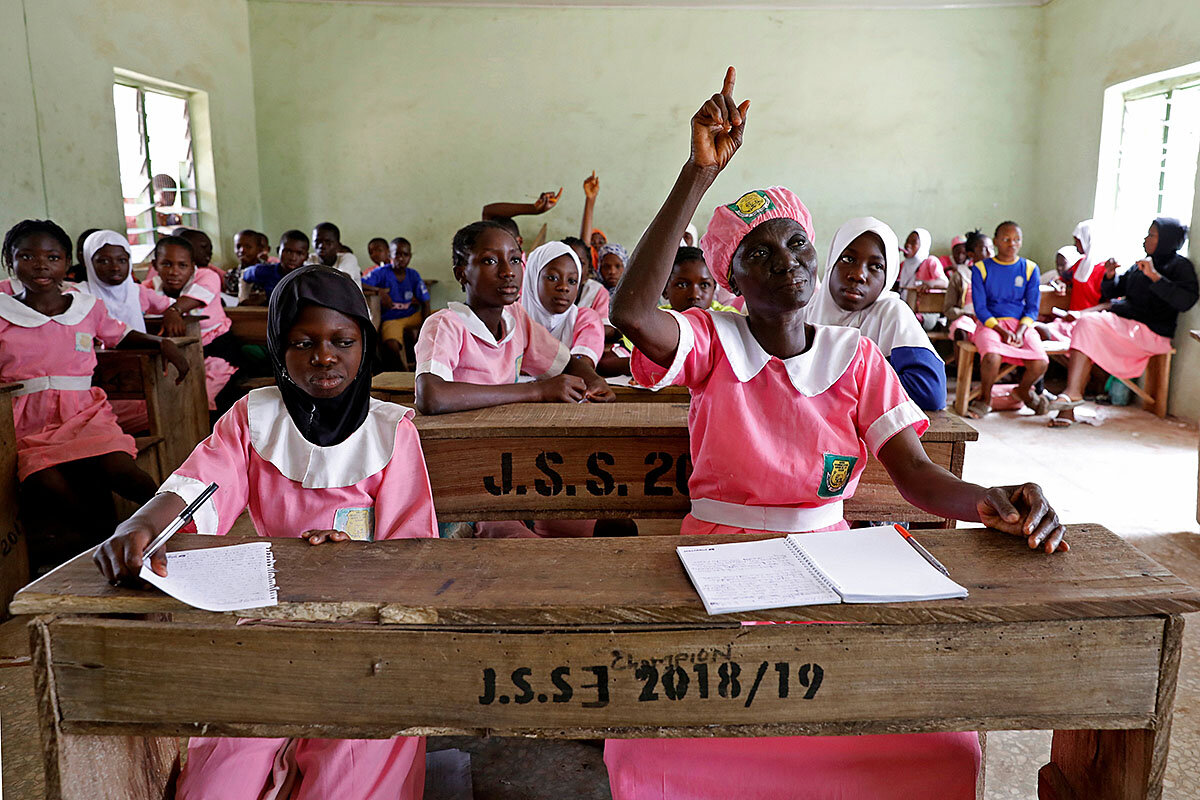
A look ahead
Thank you for joining us today. Please come back tomorrow when we explore different ideas for how to address one significant impediment to economic opportunity in the United States – how to pay for college.


